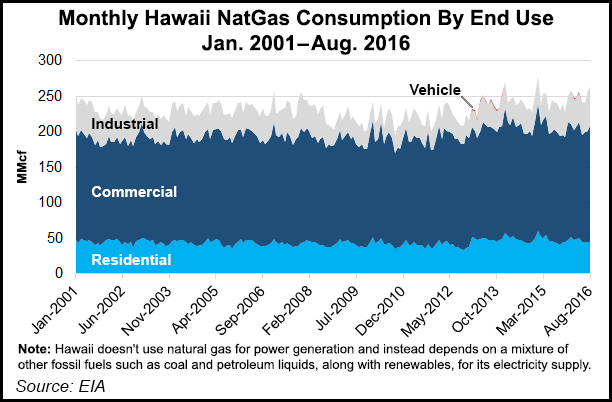Regulatory | LNG | NGI All News Access
Hawaiian Electric Utilities Going 100% Renewables; No LNG
Honolulu-based Hawaiian Electric Companies last Friday filed a plan with state regulators that would take the multi-island utility to 100% reliance on renewables by 2045.

Hawaiian Electric plans to get nearly half its power supplies from renewables by the end of 2020. Contrary to a similar document filed last April with the Hawaii Public Utilities Commission (PUC), Hawaiian Electric officials said they are not counting on any use of liquefied natural gas (LNG) for near-term power supplies. “While LNG remains a potential lower-cost bridge fuel to be evaluated, the company’s priority is to continue replacing fossil fuel generation with renewables over the next five years,” a utility spokesperson said.
Last summer, the power utility scrapped plans for an LNG contract with Fortis Hawaii Energy Inc. as well as plans to convert an existing power plant to natural gas following the termination of its proposed merger with NextEra Energy Inc.
Hawaiian Electric’s filing to the PUC is designed to “meet or exceed” the state’s renewable energy goals, which are touted as the most ambitious in the nation.
The plan calls for greater and faster expansion of the utility’s renewable energy portfolio (solar, wind battery storage and biofuels) over the next five years on each of the five islands served (Hawaii, Maui, Lanai, Molokai and Oahu).
Hawaiian Electric expects to exceed the state’s renewable milestones in 2020 and continue doing so into 2045. The state’s renewable portfolio standard (RPS) in 2020 is 30%, but the utility expects to hit 48% that year.
Similarly, the utility is forecasting to hit RPS levels of 72% in 2030 and 100% in 2040, while the state goals are 40% and 70%, respectively.
Hawaiian Electric President Alan Oshima called the PUC filing “a solid plan” that is focused on accelerating the ongoing push for renewables. “We want to work with parties from all segments of our community — government, business, community and environmental groups — to refine the plans,” he said.
Company officials said the energy transformation must balance the pursuit of renewables with price stability for retail power customers.
“Investments in grid infrastructure, as well as rising oil prices, are expected to increase the typical residential bill over the next several years, with gradually declining bills forecast to start in the mid-2020s,” the utility said.
© 2024 Natural Gas Intelligence. All rights reserved.
ISSN © 1532-1231 | ISSN © 2577-9877 |
